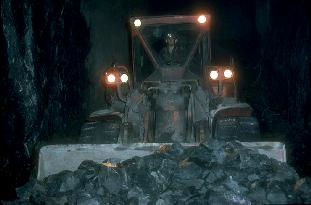Coal/Natural
Gas/Oil (Petroleums)![]()
![]() Remaining established reserves at the
beginning of 1996: natural gas, 68.1 trillion cubic feet (Tcf),
67.8 Tcf in conventional areas and 0.3 Tcf in frontier areas and
for reserves to a production ratio of 13 years. The total
in-place raw undiscovered potential of natural gas in the Western
Canada Sedimentary Basin is estimated to be 271 Tcf.
Remaining established reserves at the
beginning of 1996: natural gas, 68.1 trillion cubic feet (Tcf),
67.8 Tcf in conventional areas and 0.3 Tcf in frontier areas and
for reserves to a production ratio of 13 years. The total
in-place raw undiscovered potential of natural gas in the Western
Canada Sedimentary Basin is estimated to be 271 Tcf.
![]() Crude oil reserves were estimated at 8.7
billion (B) barrels consisting of: Conventional, 3.6 B barrels;
Oilsands, 3.8 B barrels; and Frontier, 1.3 B barrels (of which
0.85 B barrels are off the East Coast), for a reserves to
production ratio of 12 years. The ultimate recoverable potential
from the Alberta oilsands is over 300 B barrels. The economics of
recovery remain to be determined.
Crude oil reserves were estimated at 8.7
billion (B) barrels consisting of: Conventional, 3.6 B barrels;
Oilsands, 3.8 B barrels; and Frontier, 1.3 B barrels (of which
0.85 B barrels are off the East Coast), for a reserves to
production ratio of 12 years. The ultimate recoverable potential
from the Alberta oilsands is over 300 B barrels. The economics of
recovery remain to be determined.
![]() Primary energy production* by commodity in
1996 was: 32.8% petroleum, 36.8% gas, 11.7% coal, 14.8%
electricity, and 3.9% waste wood, spent pulping liquor, and
firewood for an historic high of 15 332 petajoules. Alberta
accounted for 65% of total production; B.C., 13%; Saskatchewan,
8%; Quebec, 5%; and Ontario, nearly 4%.
Primary energy production* by commodity in
1996 was: 32.8% petroleum, 36.8% gas, 11.7% coal, 14.8%
electricity, and 3.9% waste wood, spent pulping liquor, and
firewood for an historic high of 15 332 petajoules. Alberta
accounted for 65% of total production; B.C., 13%; Saskatchewan,
8%; Quebec, 5%; and Ontario, nearly 4%.

![]() Primary energy consumption* by commodity
in 1996 was: 36.4% petroleum, 25.9% gas, 11.0% coal, 20.9%
electricity, and 5.8% waste wood, spent pulping liquor, and
firewood for a total of 10 203 petajoules. Ontario accounted for
36% of total consumption; Alberta, 20%; Quebec, almost 17%; B.C.,
12%; Saskatchewan, almost 5%; Manitoba, 3%; and the Atlantic
provinces, 7%.
Primary energy consumption* by commodity
in 1996 was: 36.4% petroleum, 25.9% gas, 11.0% coal, 20.9%
electricity, and 5.8% waste wood, spent pulping liquor, and
firewood for a total of 10 203 petajoules. Ontario accounted for
36% of total consumption; Alberta, 20%; Quebec, almost 17%; B.C.,
12%; Saskatchewan, almost 5%; Manitoba, 3%; and the Atlantic
provinces, 7%.
![]() Marketable production of natural gas in
Canada in 1996 was 5.4 Tcf.
Marketable production of natural gas in
Canada in 1996 was 5.4 Tcf.
![]() Production of crude oil in Canada in 1996
was 1.34 million barrels per day (BPD) of light and 0.66 million
BPD of heavy, totalling 2.0 million BPD, or 732 million barrels
for the year.
Production of crude oil in Canada in 1996
was 1.34 million barrels per day (BPD) of light and 0.66 million
BPD of heavy, totalling 2.0 million BPD, or 732 million barrels
for the year.
![]() Canada produced 76 million tonnes of coal
valued at $1.9 billion in 1996. 88% of the coal available in
Canada, including imported coal, was used to produce electricity.
Canada produced 76 million tonnes of coal
valued at $1.9 billion in 1996. 88% of the coal available in
Canada, including imported coal, was used to produce electricity.
* Based on nuclear electricity conversion factor of 11.564 MJ/kWh.
